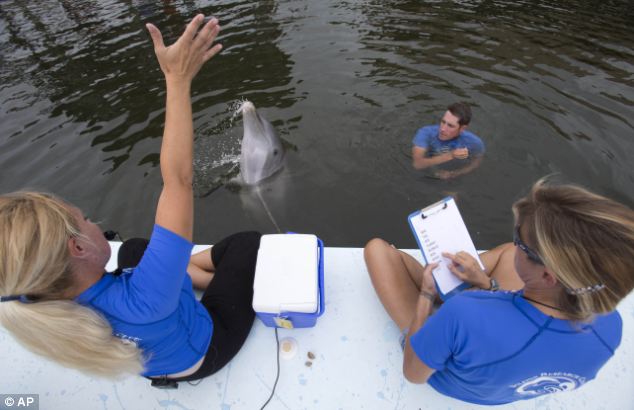 | |
| Dolphin trainer Emily Guarino puts eye cups on an Atlantic bottlenose dolphin named Tanner to blindfold him, demonstrating the dolphin uses his other senses to work out a problem |
Scientists have shown that when a dolphin is blindfolded, it can use other senses to mimic a human's movements
Tanner the dolphin used echolocation when blindfolded to replicate movements by his trainer, such as spinning in the water
The study by the Dolphin Research Centre in the Florida Keys expands on previous studies on how dolphins can imitate each other while blindfolded
A dog may be man's best friend, but dolphins can imitate human actions, and even how they solve problems, scientists have said.
When a dolphin is blindfolded, it can use other senses to mimic a human's movements, according to a recent study.
Dr Kelly Jaakkola said a bottlenose dolphin called Tanner displayed problem-solving skills by electing to swap to using echolocation when he was blindfolded in order to copy his trainer's actions.
When Tanner wasn't able to use sight to work out the movement, he switched to another technique.
The dolphin emitted sounds, listened to the echo and interpreted the resulting sound waves.
This ability - known as echolocation - allowed Tanner to replicate movements by the trainer, such as spinning in the water.
The study, conducted at the Dolphin Research Centre in the Florida Keys, expands on previous research into how dolphins are able to imitate other dolphins while blindfolded.
To see if a change in sound would affect their imitation, researchers used humans instead of dolphins to make the movements in the water.
Dr Jaakkola, research director of the marine mammal centre, said researchers were surprised by Tanner's use of echolocation.
'He outsmarted us,' she said.
Dr Jaakkola explained that dolphins must decide when to use echolocation, and said: 'that's problem-solving.'
She said: 'Of course they would use their echolocation to get more information.
'Dolphins have to solve problems all the time in the wild.'
She also explained that dolphins use their echolocation skills more at night.
During a recent demonstration in an enclosed lagoon in Grassy Key, a Florida island where the Dolphin Research Centre is located, trainer Emily Guarino got Tanner's attention by asking, 'Are you ready to play? Let's play the research game.'
Ms Guarino indicated to Tanner that he was supposed to copy her and placed latex eye cups over each eye - in effect, a dolphin blindfold.
Wordlessly that trainer began to spin in the water with his arms wrapped across his shoulders.
Tanner then did a similar spin.
For the study, published online in the scientific journal Animal Cognition, researchers tested a dozen behaviours that Tanner already knew, including bobbing up and down, blowing bubbles underwater, swimming like a shark with the tail - or feet - moving side to side and floating on top of the water.
Each behaviour was tested twice at random, with and without the blindfold, as researchers recorded echolocation sounds underwater.
Tanner was just as accurate at imitating a human - blindfolded or not - as he was at imitating another dolphin, researchers determined.
The study included six sessions spread over a nine-day period.
This kind of flexibility with imitation is more commonly associated with humans.
But people and dolphins are separated by about 90 million years of evolution, and their imitation skills likely evolved separately.
So exploring imitation in these species 'has the potential to give us clues into why imitation ever evolved at all,' Dr Jaakala said.
Further testing is needed to see if other dolphins can imitate as well as Tanner.
Dr Jaakala said: 'We have no reason to believe that this dolphin was just an Einstein dolphin that did this.'
















0 Comments